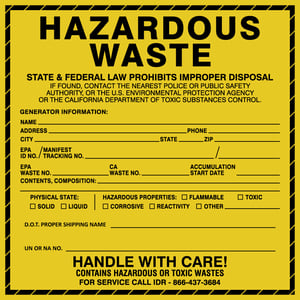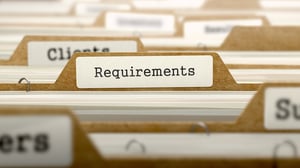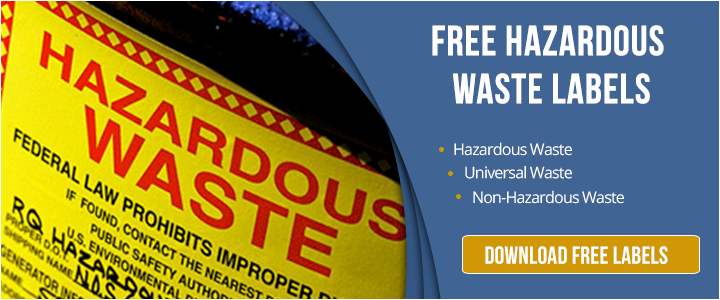If you generate hazardous waste, proper labeling is critical to ensuring you meet all state and federal regulations.
Slapping a label that you picked up at the local office supply store on a barrel of hazardous waste simply won’t do it. In fact, it could cost you a significant amount in fines and create a hazardous environment for your employees.
While it may not seem like a simple task to mark and label your company’s waste, hazardous waste generators must be aware that there are several regulations in place both at the state and federal levels for properly labeling, marking and placarding hazardous waste containers.
Failing to follow just one of these rules can open your business up to a violation, create a legal nightmare and provide a focal point for inspectors in subsequent visits.
Here is what you should know about how to label hazardous waste properly and where you can turn to for help to ensure you are meeting all requirements.
Use Proper Labels
As mentioned above, heading to the local office or packing supply store and grabbing a label is not a good  first step if your goal is to meet hazardous waste labeling requirements.
first step if your goal is to meet hazardous waste labeling requirements.
However, getting the right hazardous waste label doesn’t have to be difficult. In fact, you can download free hazardous waste labels from our site.
Waste management can be a significant investment. The good news for hazardous waste generators is there’s no need to pay for expensive labels when you can get them for free.
There are also several sites where you can order them. Before making a purchase, however, ensure that the labels you choose are in compliance with EPA and DOT regulations.
Be Aware Of State Guidelines
While federal guidelines are in effect across state lines, individual states can have their own guidelines that you should be aware of as well.
In California, for example, the Department of Toxic Substances Control (DTSC) requires the following steps when filling out labels:
- Mark clearly on the label the date each period of accumulation begins. This must be visible for inspectors on each unit.
- Labels must clearly state the words, “Hazardous Waste.”
- Label each container with:
- Composition and physical state of the waste
- A statement that includes properties of the hazardous waste
- Generator’s name and address
It’s important to note that the containers and tanks you use to consolidate wastes that were initially accumulated in other containers must follow the same labeling requirements as outlined above. After consolidating the wastes, you must put an accumulation date on the label. This date must be the oldest of the initial accumulations.
So, if you consolidate one waste that was accumulated on June 1 with a waste that was accumulated on June 15, you must record on the label June 1 as the date of accumulation.
Note: As you add more waste to the container, you may need to update the date on the label.
Follow Recurring Use Requirements
In some instances, you may have a container that you reuse on a regular basis to accumulate the same waste stream.
waste stream.
You can use “recurring use labels” on these containers to revise the initial accumulation date without having to change the other information on the label. If your workers empty a container at least once per day, you can use the word “daily” in the date area of the label.
Check That Federal Label Requirements Are Met
The state of California already requires that hazardous waste packages be labeled before they are transported off-site. This is a federal law as well through the U.S. Department of Transportation (DOT).
To meet this requirement at both the state and federal levels, if your company accumulates hazardous waste, you must place a placard on the waste or offer a placard to the initial transporter.
In addition to California’s requirements for labeling hazardous waste, you also must meet federal guidelines (many of which overlap). The DOT requires:
- Each non-bulk package with a maximum capacity of no more than 119 gallons to display:
- The shipping name and identification of the hazardous material
- Name and address of the shipper and the recipient
- Diamond hazard labels for the primary (and most subsidiary) hazard classes of the material
- Labels are properly placed on the container so handlers can easily see them. They must appear completely visible and not obscured, and should not be near any other markings on the container.
- Space between the labels if there are multiple hazards. The DOT recommends 6 inches of space between labels. The primary hazard label should be above and to the left of the subsidiary hazard label.
The U.S. Environmental Protection Agency also requires that these containers or drums are labeled with the following words:
HAZARDOUS WASTE - Federal Law Prohibits Improper Disposal. If found, contact the nearest police or public safety authority or the U.S. Environmental Protection Agency.
The EPA also requires that workers properly mark the generator’s name and address, EPA identification number and manifest tracking number be visible on the label.
Take Advantage Of The Resources Available
Hazardous waste label requirements are put into place to protect workers who must handle them and to ensure that wastes are not released mistakenly and illegally into the environment.
Choosing the right label, accurately completing it and following any other requirements that are put into place is a critical component in your hazardous waste management protocols.
Working with a reputable hazardous waste disposal company can provide your company with many benefits in the area of hazardous waste labeling.
In addition to educating you on what DTSC regulators are looking for when inspecting labels, a hazardous waste disposal company also can ensure you are meeting all cradle to grave requirements and are providing the proper training so that your business stays in compliance and exhibits the highest degree of waste management responsibility.


Comment